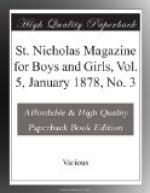We read that near the middle of the seventeenth century it was discovered that phosphorus would ignite a splint of wood dipped in sulphur; but this means of obtaining fire was not in common use until nearly a hundred and fifty years later.
This, then, appears to have been the beginning of match-making. Not that kind which some old gossips are said to indulge in, for that must have had its origin much farther back, but the business of making those little “strike-fires,” found in every country store, in their familiar boxes, with red and blue and yellow labels.
The matches of fifty years ago were very clumsy affairs compared with the “parlor” and “safety” matches of to-day, but they were great improvements upon the first in use. Those small sticks, dipped in melted sulphur, and sold in a tin box with a small bottle of oxide of phosphorus, were regarded by our forefathers as signs of “ten-leagued progress.” Later, a compound made of chlorate of potash and sulphur was used on the splints. This ignited upon being dipped in sulphuric acid. In 1829 an English chemist discovered that matches on which had been placed chlorate of potash could be ignited by friction. Afterward, at the suggestion of Professor Faraday, saltpeter was substituted for the chlorate, and then the era of friction matches, or matches lighted by rubbing, was fairly begun.
But the match of to-day has a story more interesting than that of the old-fashioned match. As we have said, much of the timber used in the manufacture comes from the immense tracts of forest in the Hudson Bay Territory. It is floated down the water-courses to the lakes, through which it is towed in great log-rafts. These rafts are divided; some parts are pulled through the canals, and some by other means are taken to market. When well through the seasoning process, which occupies from one to two years, the pine is cut up into blocks twice as long as a match, and about eight inches wide by two inches thick. These blocks are passed through a machine which cuts them up into “splints,” round or square, of just the thickness of a match, but twice its length. This machine is capable, as we are told, of making about 2,000,000 splints in a day. This number seems immense when compared with the most that could be made in the old way—by hand. The splints are then taken to the “setting” machine, and this rolls them into bundles about eighteen inches in diameter, every splint separated from its neighbors by little spaces, so that there may be no sticking together after the “dipping.” In the operation of “setting,” a ribbon of coarse stuff about an inch and a half wide, and an eighth of an inch thick, is rolled up, the splints being laid across the ribbon between each two courses, leaving about a quarter of an inch between adjoining splints. From the “setting” machine the bundles go to the “dipping” room.
After the ends of the splints have been pounded down to make them even, the bundles are dipped—both ends—–into the molten sulphur and then into the phosphorus solution, which is spread over a large iron plate. Next they are hung in a frame to dry. When dried they are placed in a machine which, as it unrolls the ribbon, cuts the sticks in two across the middle, thus making two complete matches of each splint.




